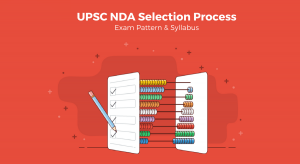Table of Contents
NDA General Ability Syllabus and Exam Pattern
Union Public Service Commission is going to conduct the National Defense Academy and naval Academy examination with the purpose to recruit most eligible candidates in Army, Navy and Air Force. Those who have ambition to enhance their career in defense sector have to qualify the exam. Applicants must check NDA Syllabus through below structured page. General Ability Section of NDA Syllabus contains two parts i.e. English and General Knowledge One can clear the exam if one practice according to the NDA Syllabus.Candidates can check NDA Syllabus and other relevant details from below of this page.
NDA SYLLABUS 2018 latest important updates with clear and comprehensive advice are given here, Candidates can assess all critical details of NDA SYLLABUS 2018 immediately here and Through this NDA SYLLABUS program, applicants can produce the plan for the Planning of exam. Direct Official Link for every single recent Updates on NDA Syllabus and Exam Pattern is Provided within These Pages. Find recent information of NDA SYLLABUS.
<<< SPIPA Civil Services Question Papers >>>
Syllabus For NDA II Exam
| Part A – English |
| · Grammar and usage · Vocabulary · Comprehension and cohesion in extended text to test the candidate’s proficiency in English |
| Part B – General Knowledge |
| Section A: Physics
· Physical Properties and States of Matter, Mass, Weight, Volume, Density and Specific Gravity, Principle of Archimedes, Pressure Barometer. · Motion of objects, Velocity and Acceleration, Newton’s Laws of Motion, Force and Momentum, Parallelogram of Forces, Stability and Equilibrium of bodies, Gravitation, elementary ideas of work, Power and Energy. · Effects of Heat, Measurement of temperature and heat, change of State and Latent Heat, Modes of transference of Heat. Sound waves and their properties, Simple musical instruments. · Rectilinear propagation of Light, Reflection and refraction. Spherical mirrors and Lenses. Human Eye. · Natural and Artificial Magnets, Properties of a Magnet, Earth as a Magnet. · Static and Current Electricity, conductors and Non-conductors, Ohm’s Law, Simple Electrical Circuits, Heating, Lighting and Magnetic effects of Current, Measurement of Electrical Power, Primary and Secondary Cells, Use of X-Rays. · General Principles in the working of the following: · Simple Pendulum, Simple Pulleys, Siphon, Levers, Balloon, Pumps, Hydrometer, Pressure Cooker, Thermos Flask, Gramophone, Telegraphs, Telephone, Periscope, Telescope, Microscope, Mariner’s Compass; Lightening Conductors, Safety Fuses. |
| Section B: Chemistry
· Physical and Chemical changes. Elements, Mixtures and Compounds, Symbols, Formulae and simple Chemical Equations, Law of Chemical Combination ( excluding problems ). Properties of Air and Water. · Preparation and Properties of Hydrogen, Oxygen, Nitrogen and Carbondioxide, Oxidation and Reduction. · Acids, bases and salts. · Carbon – different forms. · Fertilizers – Natural and Artificial · Material used in the preparation of substances like soap, Glass, Ink, Paper, Cement, Paints, Safety Matches, and Gun-Powder. · Elementary ideas about the Structure of Atom, Atomic, Equivalent and Molecular Weights, Valency. |
| Section C: General Science
· Difference between the living and non-living · Basis of Life – Cells, Protoplasm’s and Tissues · Growth and Reproduction in Plants and Animals · Elementary knowledge of human Body and its important organs · Common Epidemics, their causes and prevention · Food – Source of Energy for man. Constituents of food, Balanced Diet · The Solar System – Meteors and Comets, Eclipses. · Achievements of Eminent Scientists |
| Section D: History, Freedom Movement, etc.
· A broad survey of Indian History, with emphasis on Culture and Civilization · Freedom Movement in India · Elementary study of Indian Constitution and Administration · Elementary knowledge of Five Year Plans of India · Panchayati Raj, Co-operatives and Community Development · Bhoodan, Sarvodaya, National Integration and Welfare State, Basic Teachings of Mahatma Gandhi · Forces shaping the modern world; Renaissance, Exploration and Discovery; War of American Independence. French Revolution, Industrial Revolution and Russian Revolution. · Impact of Science and Technology on Society. · Concept of one World, United Nations, Panchsheel, Democracy. · Socialism and Communism. · Role of India in the present world. |
| Section E: Geography
· The Earth, its shape and size. Latitudes and Longitudes, Concept of time. International Date Line. · Movements of Earth and their effects. · Origin of Earth. · Rocks and their classification; Weathering – Mechanical and Chemical, Earthquakes and volcanoes. · Ocean Currents and Tides · Atmosphere and its composition; Temperature and Atmospheric Pressure, Planetary Winds, cyclones and Anti-cyclones; Humidity; Condensation and Precipitation; Types of Climate. Major Natural regions of the World. · Regional Geography of India – Climate, Natural vegetation. Mineral and Power resources; location and distribution of agricultural and industrial activities. · Important Sea ports and main sea, land and air routes of India. · Main items of Imports and Exports of India. |
| Section F: Current Events
· Knowledge of Important events that have happened in India in the recent years · Current important world events · Prominent personalities – both Indian and International including those connected with cultural activities and sports. |
<<< NDA Previous Years Question Papers pdf Solved >>>
Part A: National Defence Academy exam Syllabi for English
The question paper in English is designed to test the candidate’s understanding of the English language and workman like use of words. The syllabus covers various broad topics, like
- Grammar and Application
- Vocabulary
- Comprehension and Cohesion
UPS NDA Paper Pattern II
| Paper | Subject | Total Marks |
| General Ability test | English | 600 |
| General Knowledge |
Marking scheme of NDA NA Examination:
- There will be negative marking for every incorrect answer.
- For each wrong answer 0.33 marks will be reduced as penalty
- If more than one answer for each question has been given by candidates then they have to bear same penalty.
- If any applicants have not attempt any question then no extra marks will be deducted.
Visit Current-Affairs.org for the current affairs, previous year question papers, online quiz for the competitive exams and many more. If you need more question paper comment down your email id.




